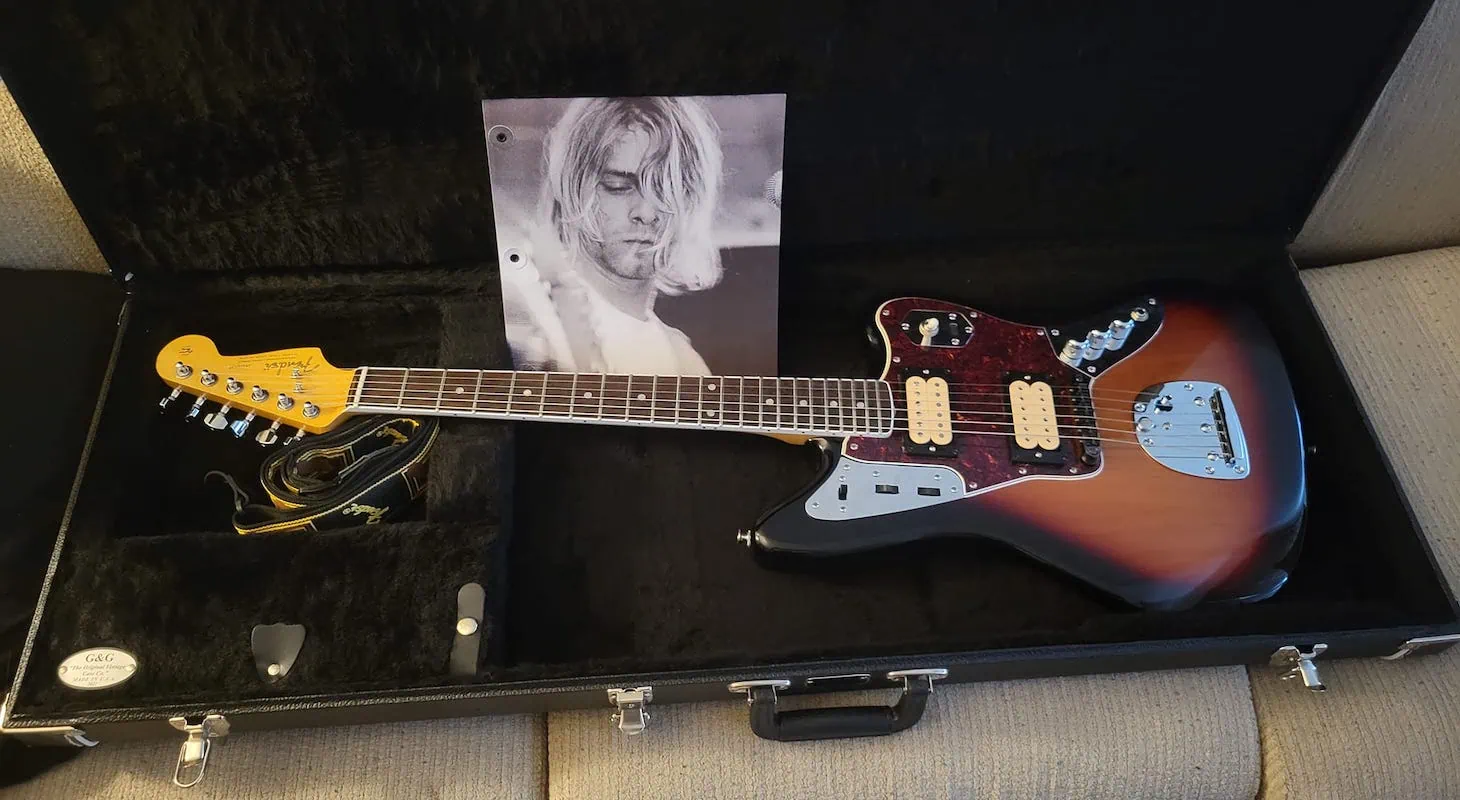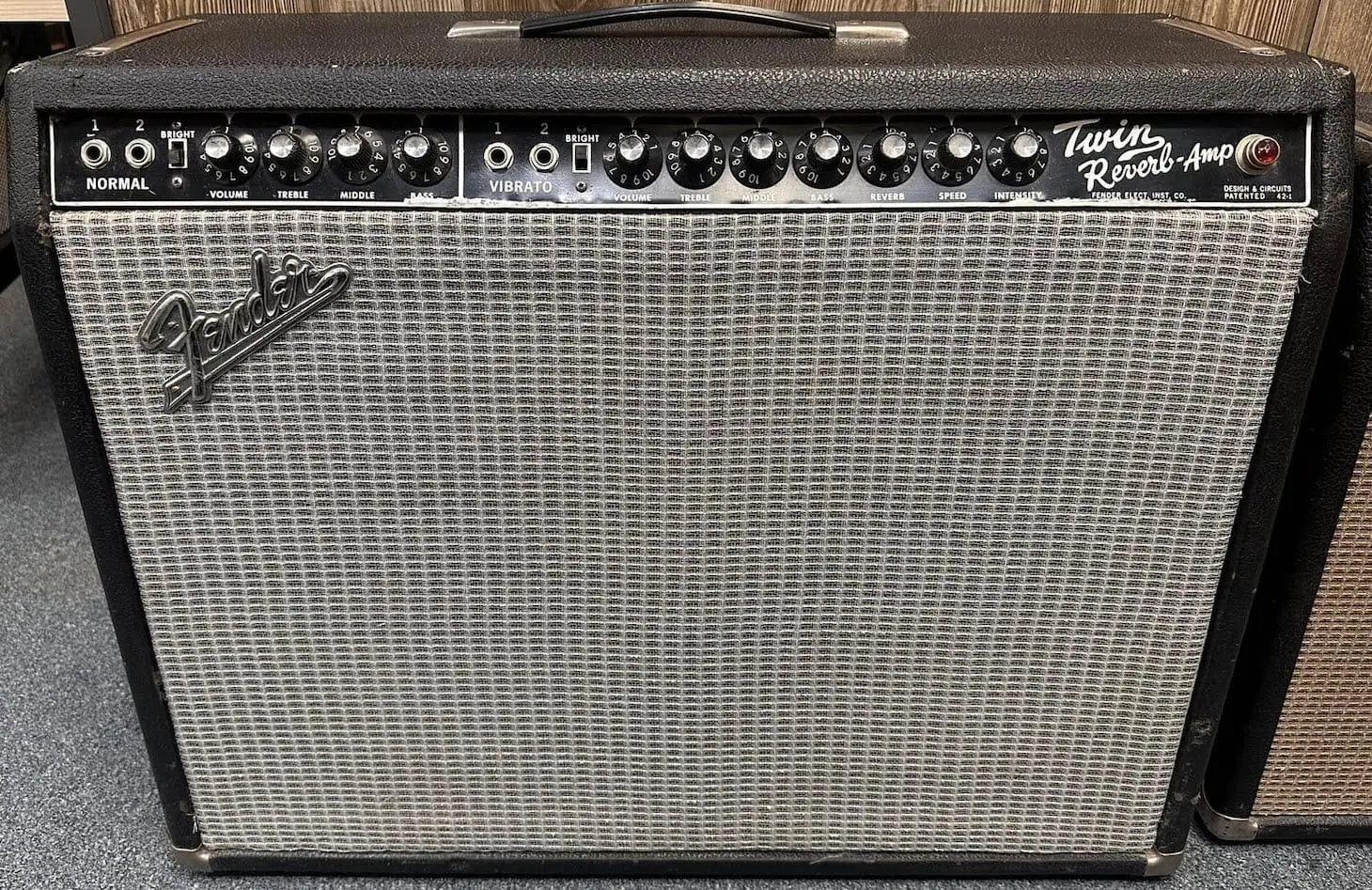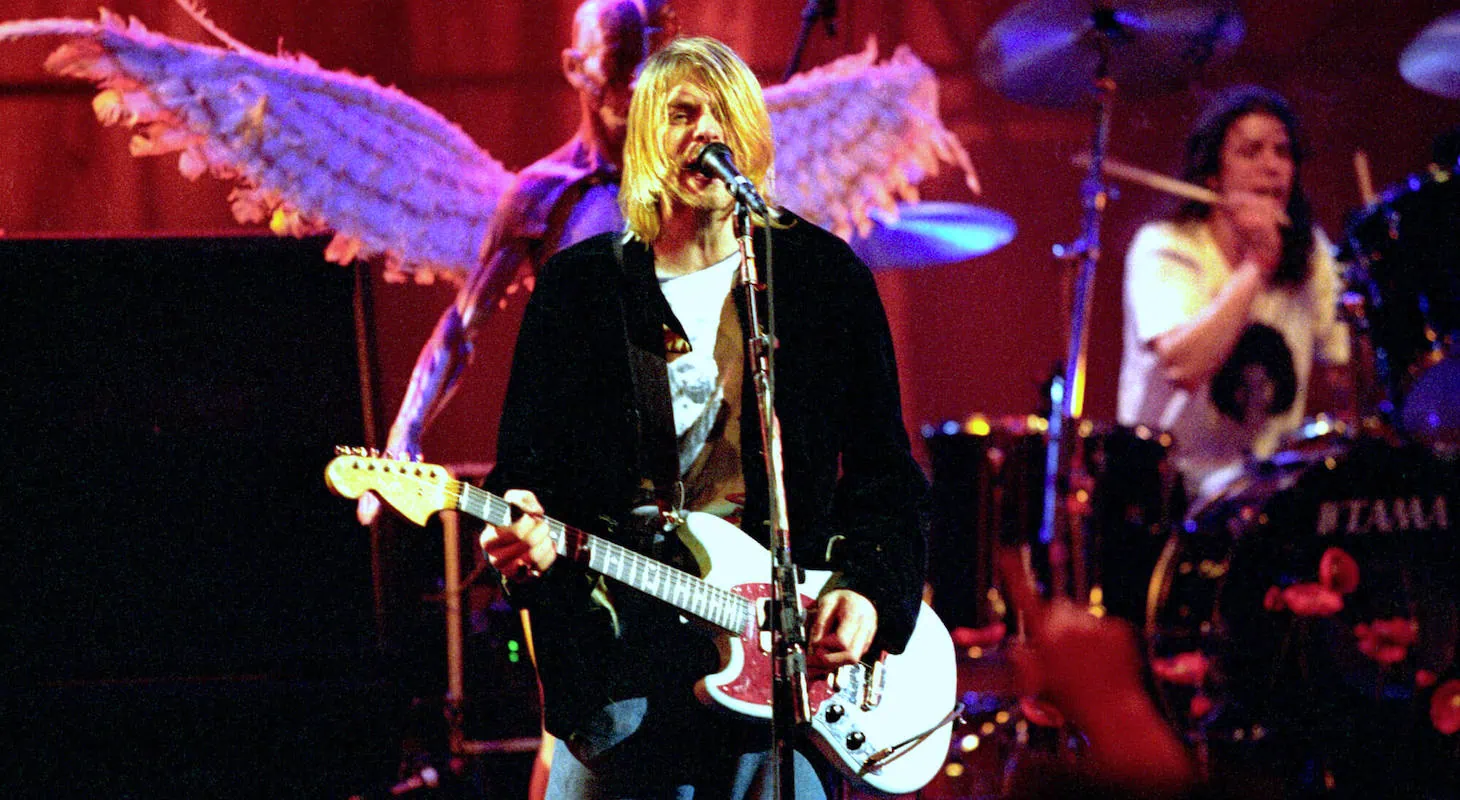Kurt Cobain’s guitar tone helped to make grunge music one of the biggest genres in the ’90s. His sound was powerful and energetic, and inspired so many guitarists, myself included.
I remember hearing “Smells Like Teen Spirit” roaring out of my 7th grade classroom’s CD player. Kurt’s voice, Dave’s thunderous drums, and that crushing, distorted tone opened my playing to a world of incredible grunge sounds.
Writing generation-defining anthems is one thing, but how did he create such an iconic sound? I embarked on a mission to mimic Kurt’s famous guitar tone.
Table of Contents
Kurt’s Guitars
The classic image of Kurt Cobain is the Nirvana frontman wielding an offset Fender, often mere minutes before he reduced it to a pile of splinters at the show’s climax.
Fortunately for us, you don’t have to be the voice of Generation X to afford the kind of guitars Kurt favored. He generally played Jaguars, Mustangs, or a combination of the two. In fact, the combination thereof inspired his signature model! (our full review)

The Player II Jag is a great guitar at a great price point, a little more affordable than the Mustang. I’d also highly recommend the 60s-style Squier Jaguar, which is closer in spirit to the pawn shop guitars Cobain played for most of his career.
Important to note, however, is that Kurt Cobain often replaced the stock single-coil pickups with aftermarket high-gain humbuckers like the DiMarzio Super Distortion.
Of course, there is audible single-coil twang to many of his classic tracks. The chorus-drenched clean sound on “Come As You Are,” for example, sounds to me like a single-coil pickup, not a full-powered humbucker.
Generally speaking, the higher gain levels Kurt Cobain used demand a powerful humbucker. The single coil of a Jaguar can feed back unpleasantly under such strain.
Curiously, Cobain seems to have enjoyed this sound: you can hear squealing feedback in the live album From the Muddy Banks of the Wishkah.
Regardless, the core of the sound, to me, is a relatively inexpensive Fender guitar. Stock pickups or DiMarzios will work well. When I’m playing “Heart Shaped Box” or “In Bloom”, I tend to dig my pick in and play on the bridge pickup, and it works great.
Kurt’s Amps
It’s worth noting that setting your amp up the right way will of course only get you so far. If you truly want to replicate Kurt Cobain’s sound, you will have to use the same, or similar, gear as him. Fortunately, Kurt Cobain’s taste in amplifiers echoes his taste in guitars: affordable, reliable gear beats luxurious boutique equipment.
Cobain generally used low-end Fender amplifiers, so I’d start there. He briefly played a solid-state Randall, but that kind of ultra-distorted Pantera-esque tone doesn’t really sound like teen spirit to me.
A 1960’s Fender Twin Reverb was the amp Cobain used for most of his career and his amp of choice. Either a ’65 Twin Reverb or ’68 Twin Reverb would be a perfect choice.

If you want something slightly cheaper, I would suggest the Tone Master Twin Reverb.
If you’re on a very tight budget, however, spending big on these Fender amps won’t make sense if you’re just trying to emulate his tone. In that case, you can go for the Bugera V5 Infinium, which is a small, budget-friendly but still highly-capable tube amp.
For bedroom practice, you can even try a compact amp packed with loads of tone presets and digital effects, like the Positive Grid Spark 2 or the Boss Katana (we’ve compared these two side-by-side here).
I’ve found that even a diminutive Fender Champ should do the trick! Most of Kurt Cobain’s distorted tone came thanks to his pedals, so in my experience the relatively clean sound of a Fender is just fine.
Failing the use of a Fender combo, I’d recommend the UAFX Dream, which models vintage Fender amplifiers. I often use this when I don’t have a Fender handy, or don’t want to lug a massive tube amp up a flight of stairs.
For something a bit louder than the Fenders, you can use a Marshall cabinet, specifically, a 1960A or a 1960AC, although the 1960AC is no longer in production and you would need to find a second-hand one. Cobain actually wound up using the Marshall extension cabinet in the studio because the speakers in his Fender combo were broken!
This isn’t a vital piece of the puzzle, although it can be nice to have the option of extra volume.
However, the MX212AR and MX412AR are both more affordable and will work just as well.
Kurt then paired his Marshall with a Mesa/Boogie Studio .22 preamp, but they are no longer in production.
The Mark series from Mesa/Boogie is a great modern alternative. The Mesa/Boogie Mark Five:25 tube amp head would be the best one to go with.
Alongside the Mesa/Boogie preamp, Kurt also used a Crown Power Base 2.
This is another vintage amp that you will likely only find second-hand and for a hefty price. In that case, I would recommend the Crown XTI 2002 800 watt as a great substitute.
As a general rule, however, I’d say the core of Kurt Cobain’s amplified sound was a Fender combo amp, buoyed by some choice effects pedals.
Kurt Cobain Amp Settings – Nirvana Guitar Tone
Unlike most other guitarists, Kurt’s guitar tech, Earnie Bailey, has spoken extensively about his gear and settings. This means that we have quite a bit of information to work with when we recreate Kurt’s sound.
Even though Kurt’s tone helped to define the sound of grunge, it wasn’t very complex. Setting all the settings on your amp to about halfway should get you close enough to his sound.
I normally start with the 4-5-6 method and then dial in from there. That means setting your EQ to 4, 5, and 6.
Or, in other words:
- Bass – 4
- Mid – 5
- Treble – 6
Some amps (especially smaller combos like the Fender Champ) might sound a bit thin, in which case you can go 5, 5, 4.
- Bass – 5
- Mid – 5
- Treble – 4
Of course, this is just a basic sound and really more of a starting point. From here, we can use Bailey’s information to tune our settings further.
Kurt wasn’t too fond of the ‘metal-like’ gain on amps like Marshalls. He preferred a smoother low-end with boosted mids and highs.
That means you want to set your bass to just above halfway. Both the mids and treble will then be dialed almost all the way to max. And since Kurt used pedals to boost his sound, the amp should be on the clean channel with the gain and reverb turned down.
Your Nirvana amp settings should then look like this:
- Bass – 6
- Mid – 8
- Treble – 8
- Gain – Off
- Reverb – Off
Here are some more specific amp settings for a few of Nirvana’s most iconic songs.
Note: I’m including gain settings for these in case you’re unable to use a discrete distortion pedal. If you do have a distortion pedal at your disposal, turn the gain down as far as you can without losing volume and use the pedal instead (I’ve included his distortion pedal settings in a separate section below).
Smells Like Teen Spirit
- Bass – 4
- Mid – 7
- Treble – 8
- Gain – 1 (verse), 9 (chorus)
Come As You Are
- Bass – 6
- Mid – 7
- Treble – 7
- Gain – 3 (verse), 7 (chorus)
Heart Shaped Box
- Bass – 4
- Mid – 6
- Treble – 5
- Gain – 2 (verse), 8 (chorus)
Lithium
- Bass – 5
- Mid – 8
- Treble – 6
- Gain – 1 (verse), 7 (chorus)
Just remember that every amp is different and these settings might not be perfect for you. Just keep fine-tuning the settings until you get it sounding just right.
Kurt Cobain’s Pedalboard & Pedal Settings
His pedalboard had a very basic setup. He didn’t use several different delays, six types of distortion, and other crazy effects. Sometimes simpler is just better.
Even though Kurt’s pedalboard wasn’t very complex, doesn’t mean it was any less important. He used pedals to great effect to shape and enhance his sound. The key pedals were distortion and chorus: these are the two building blocks for his searing lead guitar tone.
Distortion Pedals
The most important part of his pedalboard was a Boss DS-1 distortion pedal. He later replaced the DS-1 with the DS-2 which has a few more features.
And just like his amp settings, we have some detailed notes to work with when setting up the pedalboard.
The DS-1 and DS-2 will be the same, except set the turbo to 1 on the DS-2. Otherwise, turn the tone just below half and crank the distortion and level.
Kurt’s DS-1 distortion pedal settings should look like this:
- Tone – 4
- Distortion – 10
- Level – 10
- Turbo – 1
Either the DS-1 or DS-2 work great for this sound. Play the opening chords to “Teen Spirit” clean, then kick on the Boss distortion as Dave Grohl’s drums kick in. Every time I do, it just feels right.
I have also found that my EHX Big Muff can capture the denser, fuzzier sound on “Lithium” as well as that of some of the noisier tunes from In Utero. This isn’t an absolutely vital part of the tone, but it’s good to have it as an option.
Chorus Pedals
Kurt also used a few Electro-Harmonix chorus pedals in his setup. An Electro-Harmonix Small Clone, and an Electro-Harmonix Poly Chorus.
The Small Clone is straightforward. Set the depth switch to ‘up’ and the rate just below halfway.
- Depth – up
- Rate – 4
The Poly Chorus is a bit more complex with more features and different modes. In this case, set the mode to ‘chorus’.
Feedback and rate are set about halfway, with tune quite low and the width turned all the way up. For a smoother sound, you can set the filter to ‘on’.
The settings for Kurt Cobain’s Poly Chorus pedal:
- Mode – Chorus
- Feedback – 4
- Rate – 4
- Width – 10
- Tune – 2
- Filter – on
There are also some more detailed notes on the Poly Chorus settings for the famous Nirvana songs Heart-Shaped Box and Radio Friendly Unit Shifter. Kurt also kept specific notes for the solo and chorus parts in Heart-Shaped Box.
Those settings are:
Heart-Shaped Box Solo
- Feedback – 4
- Rate – 10
- Width – 2
- Tune – 10
Heart-Shaped Box Chorus
- Feedback – 4
- Rate – 4
- Width – 10
- Tune – 2
Radio Friendly Unit Shifter
- Feedback – 7
- Rate – 6
- Width – 8
- Tune – 10
Not Enough Low-end?
If you feel like your tone is a bit ‘thin’, you can add some weight with the distortion pedal. Cut back on the tone a bit on the pedal to add some more bass.
You can also add more bass with the amp, but I’ve found that the pedal will really do the best job here.
One thing to keep in mind, however, is that Cobain’s sound wasn’t too heavy on the low-end. Adding too much bass will just get you further from his sound rather than closer.
Most of the low-end thud and thunder in Nirvana’s sound comes from Dave Grohl’s aggressive drumming and the double-tracking of Kurt’s guitars.
Final Thoughts
Cobain’s guitar tone was a defining part of the Seattle grunge sound. This means that dialing in a basic grunge setting will get us pretty close to Cobain’s sound.
For such a simplistic sound and setup, Kurt Cobain helped to not only change grunge but music as a whole. He is a great example to show that you don’t need the fanciest gear to create a unique sound.
With the right guitar, amp, and some creativity, you too can recreate one of the most iconic sounds in music history.
Armed with only an entry-level Fender offset, an affordable Fender amp, and chorus and distortion pedals, I’ve been able to get in the ballpark of Kurt Cobain’s iconic sound. That’s a tone recipe you can’t just say “never mind” to!

